Indulge in the art of crafting the perfect charcuterie board. From selecting the finest meats to expertly pairing flavors, this comprehensive guide will ignite your culinary creativity. Whether you're hosting a gathering or simply treating yourself, join us on a flavorful journey as we delve into the world of meats for charcuterie boards. Get ready to tantalize taste buds, impress guests, and elevate your appetizer game to new heights. Are you ready to curate a stunning spread that will have everyone coming back for seconds? Let's dive in and unlock the secrets to creating a charcuterie masterpiece.
Fast-track your charcuterie skills and connect with 514K experts. Click for instant access to our comprehensive guide and community >>
Table of Contents [CLICK HERE TO OPEN]
- The Star Of The Show
- Essential Meats for Charcuterie Boards
- Curing Techniques and Flavor Profiles
- Pairing Meats with Cheeses and Accompaniments
- Specialty and Unique Meats for Exquisite Charcuterie
- Regional Charcuterie Delicacies and Flavor Influences
- Staying Mindful of Dietary Considerations
- Tips for Assembling an Impressive Charcuterie Board
- Wrapping It Up
- Frequently Asked Questions
The Star Of The Show
In recent years, charcuterie boards have experienced a surge in popularity, thanks to their ability to elevate any occasion. They are no longer just a simple appetizer option; they have become the centerpiece that sparks conversations and leaves a lasting impression on guests.
So, what makes a charcuterie board so extraordinary? It all begins with the careful selection of meats. These cured delights are the heart and soul of any charcuterie creation. They bring a symphony of flavors, textures, and aromas that ignite the senses and invite culinary exploration.
When choosing meats for your charcuterie board, it's important to consider the overall experience you want to create. Are you looking for a classic combination that embodies timeless elegance, or are you inspired by bold and innovative flavors? The choice is yours, and the possibilities are endless.

What We'll Be Covering
In the following sections, we will delve into the essentials of charcuterie meats, unravel the mysteries of curing techniques, and guide you through the art of pairing and presentation. We will also introduce you to regional variations, showcase specialty meats, and ensure that dietary considerations are not overlooked. By the end of this journey, you will be equipped with the knowledge and inspiration to curate a charcuterie board that embodies your unique style and delights every palate.
Get ready to embark on a culinary adventure, where your creativity knows no bounds. It's time to elevate your charcuterie game and create an unforgettable experience for yourself and your guests. So, let's dive into the world of meats for charcuterie boards and unlock the secrets to crafting a masterpiece that will leave everyone wanting more.
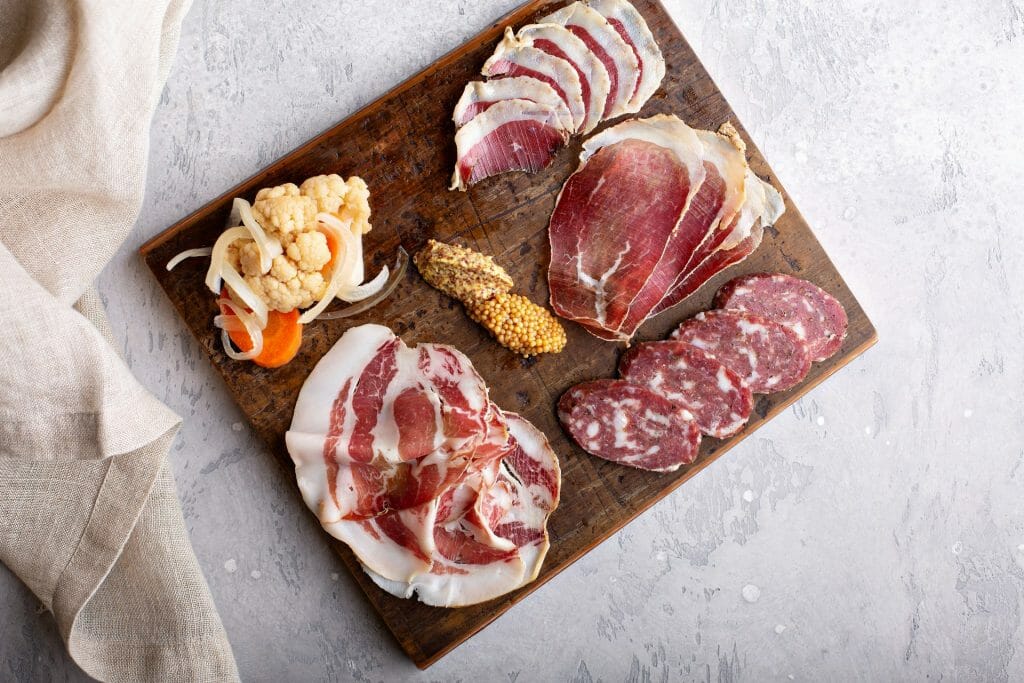
Essential Meats for Charcuterie Boards
When it comes to creating a memorable charcuterie board, the selection of meats plays a starring role. These essential meats not only bring a burst of flavors but also provide a range of textures that harmonize with cheeses, accompaniments, and your personal preferences.
Let's dive into the world of essential meats for charcuterie boards:
Prosciutto
This iconic Italian dry-cured ham steals the spotlight with its delicate, melt-in-your-mouth texture and subtly salty flavor. Its buttery richness pairs beautifully with creamy cheeses like Brie or fresh mozzarella. Add a drizzle of balsamic glaze, and you have a heavenly combination that will leave taste buds dancing.
Salami
Salami comes in various regional styles and flavors, offering a versatile addition to your charcuterie spread. From the classic Genoa salami to the spicy Calabrese salami, these air-dried sausages bring a robust, savory profile to the board. Pair them with aged cheddar or tangy goat cheese for a delightful balance of flavors.
Soppressata
Originating from Southern Italy, soppressata is a dry-cured sausage characterized by its spicy kick and rustic charm. Its coarse texture and bold flavors make it an excellent choice for those who crave a bit of heat on their charcuterie board. Complement it with a creamy Gorgonzola or a tangy Pecorino Romano for a tantalizing contrast.
Pancetta
Pancetta, Italy's beloved cousin to bacon, is a must-have on any charcuterie board. This unsmoked Italian cured pork belly boasts a rich, buttery taste and a delicate marbling of fat. Its versatility shines when wrapped around breadsticks or folded next to soft, creamy cheeses like Camembert or triple cream Brie.
Chorizo
Known for its vibrant red color and robust, smoky flavor, chorizo adds a touch of spice to your charcuterie adventure. Whether it's Spanish or Mexican chorizo, both varieties lend a distinct character to the board. Pair slices of smoky chorizo with Manchego cheese or queso fresco for a delightful fusion of flavors.
Coppa
Coppa, also known as capocollo, is a traditional Italian cold cut made from pork shoulder. It features a delicate marbling of fat and a rich, savory taste. With its tender texture and nuanced flavor, coppa complements a wide range of cheeses, from nutty Gouda to creamy Havarti.
Mortadella
Originating from Bologna, Italy, mortadella is a large, cylindrical sausage famous for its smooth texture and delicate aroma. Its signature blend of finely ground pork, luscious fat, and aromatic spices make it a crowd-pleaser. Pair thin slices of mortadella with creamy goat cheese or a sharp provolone for a match made in charcuterie heaven.
Bresaola
Bresaola is an air-dried, salted beef that hails from the Lombardy region of Italy. Its lean, tender slices have a rich, slightly sweet flavor with hints of nuttiness. Pair bresaola with a mild, creamy cheese like fresh mozzarella or a slice of Parmigiano-Reggiano to experience a delightful interplay of textures and tastes.
Capicola
Capicola, also known as capocollo or gabagool, is a traditional Italian cold cut made from pork shoulder. It boasts a marbled texture, rich flavor, and a hint of spiciness. Its versatility shines when paired with sharp provolone or aged Gouda, creating a delightful balance of flavors.
Remember, the key to a captivating charcuterie board is the interplay of flavors. Experiment with different combinations of meats, cheeses, and accompaniments to create a harmonious symphony for your taste buds. Let your imagination run wild as you curate a personalized selection that reflects your culinary style and delights your guests.
Now that we've explored the essential meats, let's dive deeper into the art of curing techniques and flavor profiles to elevate your charcuterie board to new heights.

Curing Techniques and Flavor Profiles
Curing techniques are at the heart of creating the distinctive flavors and textures found in charcuterie meats. From the centuries-old traditions of dry-curing and salt-curing to the smoky allure of smoking, each method imbues the meats with its own unique character. Let's explore these techniques and their impact on flavor and texture:
Dry-Curing
Dry-curing involves applying a mixture of salt, herbs, and spices to the meat's surface and allowing it to air-dry over a period of weeks or months. This process draws out moisture, concentrates flavors, and intensifies the meat's natural richness. The result is a firm texture, concentrated flavors, and a depth of umami that delights the palate. Prosciutto and bresaola are prime examples of dry-cured meats that bring a sublime depth of flavor to your charcuterie board.
Salt-Curing
Salt-curing, also known as brining, involves immersing the meat in a saltwater solution or rubbing it with salt to preserve and flavor it. This method creates a moist and tender texture while infusing the meat with a well-balanced saltiness. Salt-cured meats like pancetta and capicola add savory complexity to your charcuterie board. Remember to rinse off excess salt or soak the meat before using to achieve the desired flavor profile.
Smoking
Smoking is a technique that imparts rich, smoky flavors to the meat. The meat is exposed to smoke from wood chips or logs, slowly absorbing the aromatic compounds produced during the smoking process. This adds depth and complexity to the flavors, enhancing the overall taste experience. Smoked meats like chorizo or smoked turkey breast bring a captivating smokiness to your charcuterie board, creating a delightful contrast to milder flavors.
Aging
Aging is a process that involves allowing the meat to mature under controlled conditions, typically in a temperature- and humidity-controlled environment. This extended aging period allows the flavors to develop, the meat to tenderize, and the umami notes to deepen. The result is a melt-in-your-mouth texture and complex flavors. Meats like salami and soppressata benefit from aging, creating a remarkable depth of flavor that enhances your charcuterie board.
When pairing cured meats on your charcuterie board, it's important to consider complementary flavors. For example, the delicate saltiness of prosciutto pairs wonderfully with the creamy, tangy notes of goat cheese, while the smoky intensity of chorizo finds harmony alongside the nutty flavors of aged Gouda. Experiment with different combinations and trust your taste buds to find the perfect balance.
As we continue on our charcuterie journey, let's explore the art of pairing meats with cheeses and a delightful array of accompaniments that will elevate your charcuterie board to a whole new level of flavor symphony.
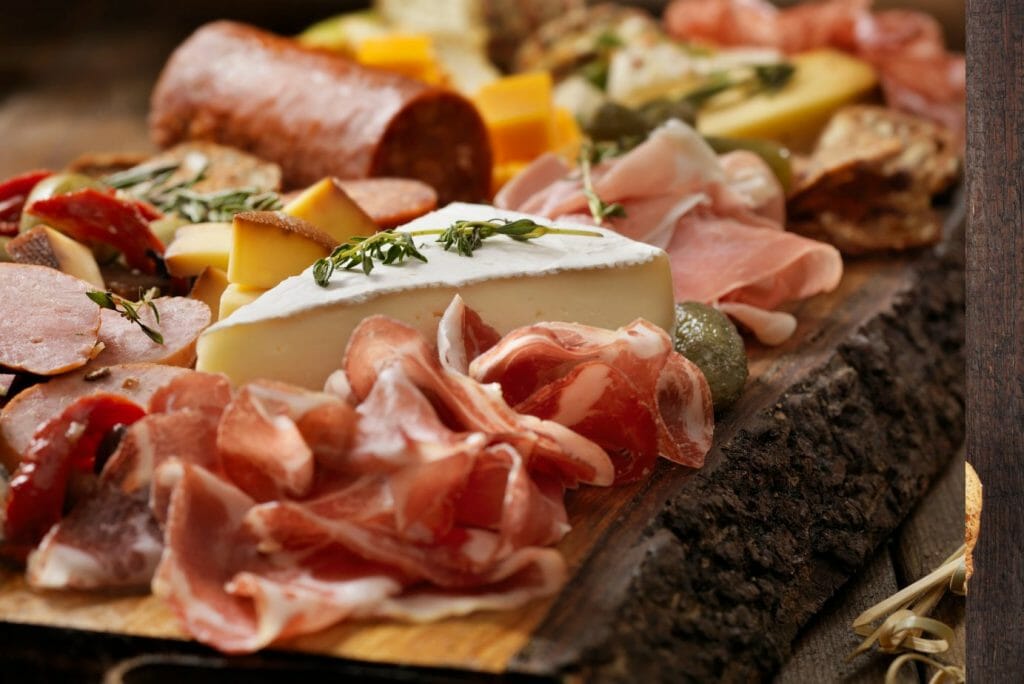
Pairing Meats with Cheeses and Accompaniments
Creating a remarkable charcuterie board is an art that involves carefully pairing different meats with specific types of cheese. The interplay of flavors and textures between the meats and cheeses creates a symphony of taste sensations that will leave your palate yearning for more. Let's dive into the art of pairing and discover the perfect accompaniments to enhance the meat and cheese combination:
Prosciutto and Soft Cheeses
The delicate, buttery flavors of prosciutto pair exceptionally well with soft, creamy cheeses like Brie or Camembert. The contrast between the salty, savory prosciutto and the luscious, mild cheese creates a perfect balance. Spread a bit of Brie onto a cracker, top it with a thin slice of prosciutto, and let the flavors mingle in your mouth for a heavenly experience.
Salami and Aged Cheeses
The robust flavors of salami find their match in aged cheeses such as Parmigiano-Reggiano or aged Gouda. The intensity of the salami complements the nutty, complex flavors of these cheeses, creating a dynamic combination. Shave some Parmigiano-Reggiano over slices of salami or pair a chunk of aged Gouda with a spicy salami for a bold and satisfying bite.
Soppressata and Sharp Cheeses
The spicy notes of soppressata harmonize beautifully with sharp, tangy cheeses like Pecorino Romano or aged cheddar. The kick from the soppressata is balanced by the bold flavors of these cheeses, resulting in a palate-pleasing fusion. Combine slices of soppressata with shards of Pecorino Romano or serve it alongside cubes of aged cheddar for a tantalizing flavor combination.
Pancetta and Fresh Cheeses
The unsmoked, subtly sweet flavors of pancetta shine when paired with fresh, tangy cheeses such as goat cheese or feta. The saltiness of the pancetta is complemented by the bright, creamy notes of these cheeses, creating a delightful contrast. Wrap a slice of pancetta around a dollop of goat cheese or crumble some feta over crispy pancetta for a burst of flavors.
When selecting accompaniments for your meat and cheese pairing, consider options that enhance the overall experience. Here are some suggestions to elevate your charcuterie board:
- Crackers and Bread: Choose a variety of textures and flavors, such as crispy baguette slices, crunchy artisanal crackers, or hearty whole-grain bread.
- Olives and Pickles: Add a touch of briny goodness with a selection of olives like Kalamata or Castelvetrano, along with tangy pickles such as cornichons or pickled onions.
- Condiments: Offer an array of condiments like grainy mustard, fig jam, honey, or balsamic glaze to add depth and complexity to each bite.
- Fruits and Nuts: Include fresh fruits like grapes, sliced pears, or figs for a touch of sweetness. Add a variety of nuts such as almonds, walnuts, or pistachios for a delightful crunch.
Remember, the goal is to achieve a harmonious balance of flavors and textures. Experiment with different combinations, trust your taste buds, and let your creativity shine as you curate a charcuterie board that tantalizes and delights.
Now that we've explored the art of pairing meats with cheeses and the perfect accompaniments, let's dive into the world of specialty and unique meats that will take your charcuterie board to new heights of culinary exploration.
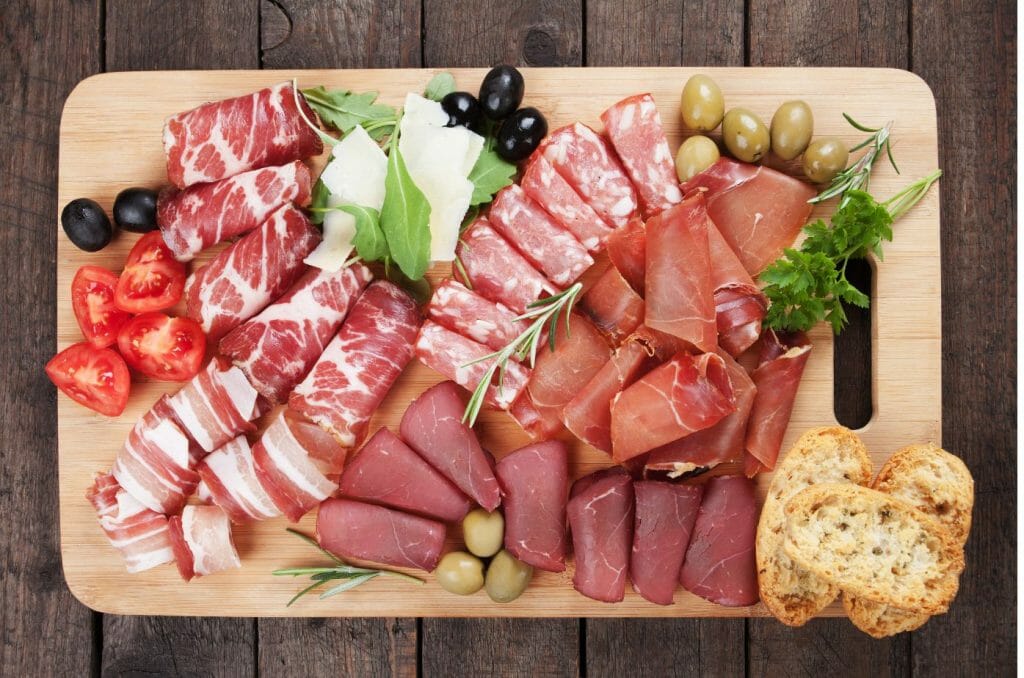
Specialty and Unique Meats for Exquisite Charcuterie
Are you ready to take your charcuterie board to the next level? Prepare to embark on a journey of extraordinary flavors and culinary exploration as we showcase a selection of specialty and unique meats that will elevate your charcuterie experience to new heights.
Duck Confit
Duck confit is a French delicacy where duck legs are slow-cooked in their own fat until tender and succulent. This rich and flavorful meat brings a luxurious touch to your charcuterie board. Pair it with a tangy cranberry chutney or a dollop of fig compote to balance the richness. Serve it alongside a creamy Brie or a slice of fresh baguette for a combination that will transport your taste buds to gourmet heaven.
Venison
Venison, the lean and tender meat from deer, offers a unique flavor profile that adds a touch of wild elegance to your charcuterie spread. Its robust and earthy taste pairs beautifully with fruity accompaniments like lingonberry jam or red currant preserves. Try it alongside a crumbly blue cheese or a creamy goat cheese for a delightful contrast of flavors.
Rabbit
Rabbit meat, known for its delicate texture and subtle flavor, brings a touch of sophistication to your charcuterie board. Its mild and slightly sweet taste pairs wonderfully with tart pickled vegetables or a zesty lemon aioli. Serve it alongside a creamy Camembert or a nutty Gruyère to create a combination that will delight even the most discerning palates.
Foie Gras
Foie gras, a delicacy made from the fattened liver of ducks or geese, offers an unparalleled richness and luxurious texture. Its buttery and velvety smoothness pairs exquisitely with sweet accompaniments like caramelized onions or a drizzle of port wine reduction. Spread it on a thin slice of toasted baguette or pair it with a delicate goat cheese to create a symphony of indulgence.
Pâté and Terrine
Pâtés and terrines encompass a variety of finely ground or coarsely textured meats, blended with herbs, spices, and other flavorful ingredients. These savory delights add depth and complexity to your charcuterie board. Try a country-style pork pâté with cornichons or a rustic terrine with whole-grain mustard. Serve them alongside a crusty artisanal bread or a tangy aged cheddar for a delightful combination of tastes and textures.
These specialty and unique meats bring diversity and an element of surprise to your charcuterie board. Pair them with complementary flavors to create unforgettable taste experiences. Remember, the key is to strike a balance between the intense flavors of these meats and the accompaniments that enhance their profiles.
Now that you've discovered the extraordinary world of specialty meats, get creative with your pairings and accompaniments. Allow your taste buds to explore new territories and let your charcuterie board become a canvas for gastronomic artistry.
As we continue our journey, let's venture into the regional charcuterie delicacies and flavor influences that will transport you to the culinary landscapes of different cultures and regions.
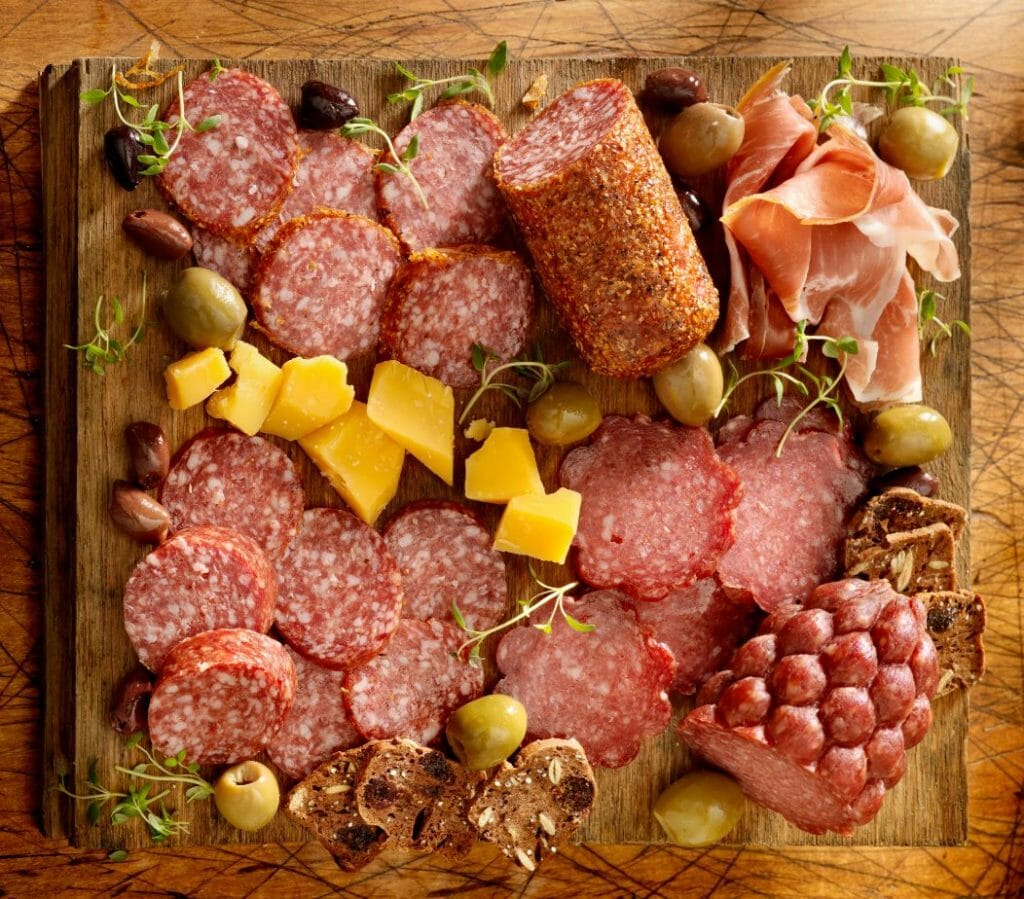
Regional Charcuterie Delicacies and Flavor Influences
Charcuterie is not only a culinary delight but also a reflection of regional traditions and flavor profiles. As we embark on a journey through various regions, we discover the distinctive charcuterie delicacies and the cultural influences that shape their flavors.
Italian Charcuterie
Italian charcuterie is renowned for its diverse array of meats and its commitment to time-honored traditions. Prosciutto di Parma, made from the hind legs of specially bred pigs, is a staple of Italian charcuterie. Its delicate saltiness and buttery texture make it an irresistible addition to any charcuterie board. Other Italian specialties include salami, such as the spicy Calabrese or the aromatic Finocchiona, and the luxurious mortadella with its signature pistachios. The art of Italian charcuterie is deeply rooted in regional pride and quality craftsmanship.
Spanish Charcuterie
Spanish charcuterie boasts bold flavors and a vibrant culinary heritage. Jamón Ibérico, made from acorn-fed Iberian pigs, is a star of Spanish charcuterie. Its rich marbling and nutty undertones create a truly indulgent experience. Chorizo, both spicy and sweet, adds a punch of flavor, while lomo (cured pork loin) offers a lean and savory option. Spanish charcuterie reflects the country's passion for tradition, celebration, and the vibrant ingredients that define its culinary landscape.
French Charcuterie
French charcuterie showcases elegance, refinement, and an unparalleled attention to detail. The country's charcuterie offerings include the iconic saucisson sec, a dry-cured sausage that varies in flavor depending on the region. Rillettes, a pâté-like spread made from slow-cooked meat, provides a luxurious addition to the charcuterie board. And let's not forget about the delectable pâté de campagne, a rustic country-style pâté. French charcuterie exemplifies the art of preserving and transforming humble ingredients into culinary masterpieces.
German Charcuterie
German charcuterie, or Wurst, holds a special place in the world of sausages. From the smoky and garlicky notes of the Thüringer Rostbratwurst to the spiced and tangy flavors of the Nürnberger Bratwurst, German sausages offer a wide range of tastes and textures. The iconic Black Forest ham, known for its distinct smokiness, is a beloved component of German charcuterie. German charcuterie showcases the country's dedication to hearty, robust flavors and time-honored craftsmanship.
Each regional style of charcuterie reflects the cultural heritage, climate, and culinary traditions of its respective country. The unique flavor profiles, techniques, and ingredients used in these regions contribute to the diverse world of charcuterie.
When curating your charcuterie board, consider incorporating meats from different regions to create a culinary journey for your taste buds. Combine Italian prosciutto with Spanish chorizo, or French saucisson sec with German Black Forest ham. Embrace the flavors and cultural influences that come together on your board, and let your charcuterie experience be a celebration of global gastronomy.
As our charcuterie exploration continues, we will address the dietary considerations and offer tips on assembling an impressive charcuterie board that caters to different preferences and dietary needs.

Staying Mindful of Dietary Considerations
When creating a charcuterie board, it's important to consider the dietary preferences and restrictions of your guests. With a mindful approach, you can ensure that everyone can indulge in the deliciousness of charcuterie. Let's explore some considerations and options for accommodating various dietary needs:
Gluten-Free Options
For those following a gluten-free diet, it's essential to be aware of potential gluten-containing ingredients in certain charcuterie meats. Some sausages or processed meats may include breadcrumbs or other gluten-based fillers. Look for gluten-free labels or opt for naturally gluten-free options like prosciutto, certain salamis, or cured meats without added ingredients. Ensure that any accompanying bread or crackers are also gluten-free, or offer alternatives like gluten-free rice crackers or vegetable sticks for dipping.
Keto-Friendly Choices
If you're following a keto diet or aiming for low-carb options, selecting meats with minimal or no added sugars is key. Look for sugar-free or all-natural options like uncured bacon, sugar-free smoked meats, or air-dried sausages without added sugars. Pair these meats with high-fat cheeses like aged cheddar or blue cheese for a satisfying and keto-friendly combination.
Vegetarian/Vegan Alternatives
For vegetarian or vegan guests, it's important to offer alternatives to traditional charcuterie meats. Explore plant-based options such as vegan deli slices, tofu-based “faux gras,” or marinated tempeh. These alternatives provide a similar texture and flavor experience without the use of animal products. Additionally, incorporating a variety of fresh fruits, vegetables, and dairy-free cheeses into your charcuterie board will enhance the vegetarian or vegan options available.
Label Reading and Specialized Products
When catering to specific dietary needs, it's crucial to read labels carefully. Look out for any potential allergens, additives, or ingredients that may conflict with dietary preferences or restrictions. Seek out specialized products, such as gluten-free or keto-friendly charcuterie meats, that are specifically crafted to meet dietary needs. Local specialty food stores or online retailers may carry a wide range of options for various dietary considerations.
Remember, clear labeling and communication can help your guests make informed choices. Consider providing small signs or cards that indicate which meats are gluten-free, keto-friendly, or suitable for specific dietary preferences. This thoughtful gesture will ensure that everyone feels included and can enjoy the charcuterie experience.
By considering dietary considerations and offering alternatives, you can create a charcuterie board that caters to a diverse range of preferences and dietary needs. It's an opportunity to showcase your creativity and thoughtfulness, making every guest feel welcome and indulged.
As we near the end of our charcuterie journey, we will conclude with tips on presentation, styling, and garnishing techniques to elevate the visual appeal of your charcuterie board and leave a lasting impression on your guests.
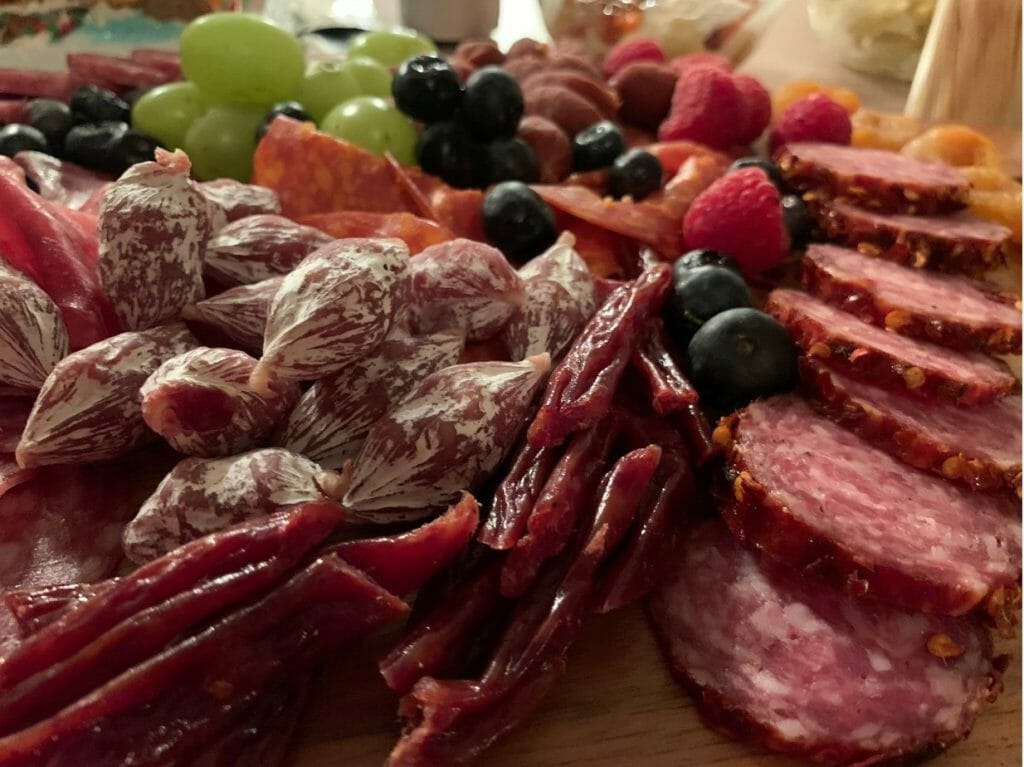
Tips for Assembling an Impressive Charcuterie Board
Now that you have gathered an exquisite selection of meats, cheeses, and accompaniments, it's time to bring them together in a visually stunning and delicious charcuterie board. Follow these step-by-step tips to assemble a jaw-dropping masterpiece that will leave your guests in awe:
Select the Right Platter
Choose a platter or board that suits the size of your gathering and provides ample space to showcase the charcuterie components. Wooden cutting boards, marble slabs, or slate tiles can all make stylish and functional choices. Consider the overall aesthetic you wish to achieve, whether it's rustic, elegant, or modern, and select a platter that complements that style.
Plan the Layout
Before placing any items on the board, plan the layout in your mind or sketch it out on paper. Visualize the placement of meats, cheeses, accompaniments, and any additional garnishes. Aim for a balanced arrangement, alternating colors, textures, and heights to create an eye-catching display.
Start with Meats
Begin by arranging the meats on the board. Fan out slices of prosciutto, roll salami or soppressata into neat bundles, and fold thin slices of pancetta. Consider draping slices of meat over the edge of the board for an added touch of visual appeal. Leave enough space between each meat variety to allow for easy selection and sampling.
Place Cheeses Strategically
Position the cheeses strategically, considering their shapes, sizes, and textures. Slice firm cheeses like Cheddar or Gouda and stack them neatly. Crumble or cut softer cheeses like goat cheese or Brie and place them in small bowls or ramekins. Scatter the cheeses across the board, ensuring they are evenly distributed and easily accessible to guests.
Add Accompaniments
Arrange the accompaniments around the meats and cheeses. Place small dishes of olives, pickles, or condiments in empty spaces on the board. Scatter fresh fruits like grapes or figs to add pops of color. Fill gaps with an assortment of crackers, breadsticks, or artisanal bread slices. Keep in mind the balance of flavors and textures, ensuring that each accompaniment complements the charcuterie components.
Enhance with Garnishes
Take your charcuterie board to the next level by adding artistic garnishes. Sprinkle fresh herbs like rosemary or thyme over the meats and cheeses for a touch of greenery. Place a small bowl of whole grain mustard in the center or add a drizzle of honey over a cheese wedge. These simple garnishes add visual interest and enhance the overall experience.
Serve and Enjoy
When it's time to serve, provide small cheese knives, spreaders, and serving utensils for guests to use. Consider labeling certain meats, cheeses, or accompaniments if they have unique flavors or ingredients. Invite your guests to explore the flavors, experiment with different combinations, and savor the charcuterie experience.
Remember, presentation is key, but so is practicality. Ensure that guests can easily access the charcuterie items and that the arrangement allows for smooth flow and interaction. Periodically replenish items as needed to maintain the visual appeal and abundance of the board throughout the event.
By following these tips, you'll assemble an impressive charcuterie board that not only tantalizes the taste buds but also captures the eyes and hearts of your guests.
As we conclude our charcuterie adventure, let's reflect on the artistry, flavors, and cultural significance of charcuterie, and how this versatile culinary tradition continues to captivate and inspire food enthusiasts worldwide.

Wrapping It Up
As we come to the end of our charcuterie journey, we are reminded of the importance of selecting the right meats for a remarkable charcuterie board. Each meat brings its own distinct flavors, textures, and cultural influences, contributing to the symphony of tastes that make charcuterie so captivating.
The beauty of charcuterie lies not only in the tantalizing flavors but also in its versatility. Whether you're hosting a casual gathering, a special occasion, or an intimate night in, a well-crafted charcuterie board serves as a centerpiece that invites connection, conversation, and culinary exploration. It brings people together to savor the artistry of food and create memorable experiences.
So, the next time you're planning an event or simply indulging in a culinary treat, remember the art of selecting the right meats for your charcuterie board. Explore the endless possibilities, embrace the regional specialties, and let your taste buds guide you. And above all, enjoy the journey of creating and savoring a charcuterie board that is truly a work of edible art.
Now, gather your meats, cheeses, accompaniments, and let the magic of charcuterie unfold. Bon appétit!
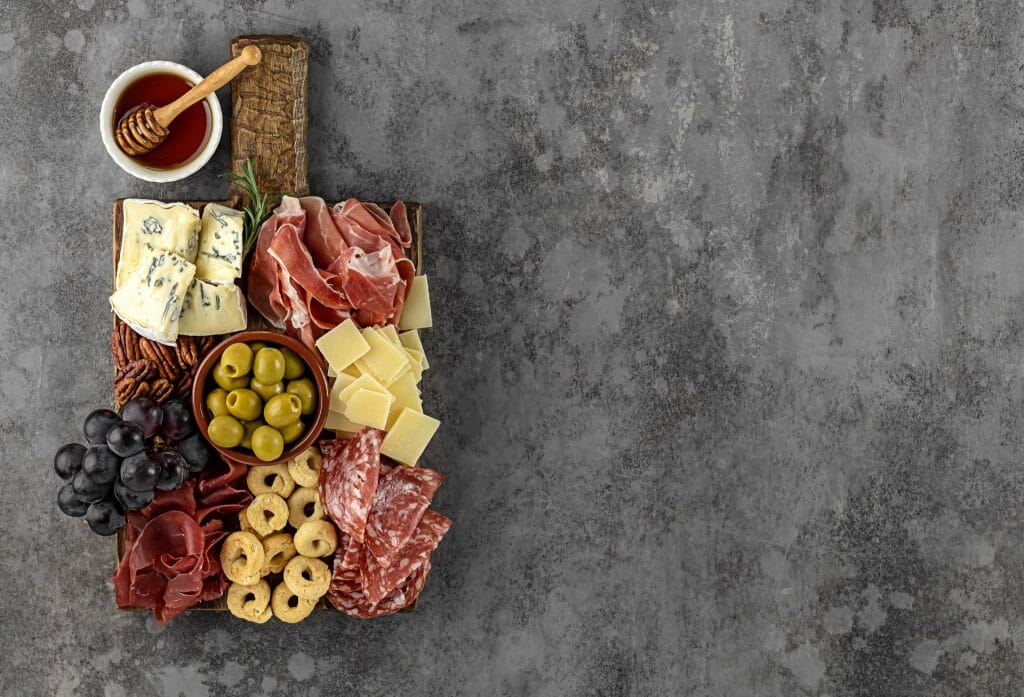
Frequently Asked Questions
What meats go on a charcuterie board?
Common meats for a charcuterie board include prosciutto, salami, soppressata, pancetta, chorizo, coppa, mortadella, bresaola, and capicola. These meats offer a variety of flavors, textures, and origins, creating a diverse and delicious spread.
What meat is best with cheese and crackers?
When pairing meats with cheese and crackers, options like prosciutto, salami, and aged cheddar are popular choices. These meats offer a balance of flavors that complement the richness of the cheese, while crackers provide a crunchy base. Experiment with different combinations to find your favorite pairing.
What is the most popular meat on a charcuterie board?
The most popular meat on a charcuterie board is often prosciutto. Its delicate flavor, melt-in-your-mouth texture, and versatility make it a favorite choice among charcuterie enthusiasts. However, preferences may vary, and other popular meats include salami, soppressata, and cured ham. Consider personal taste and desired flavor profiles when selecting meats for your charcuterie board.
How do you pick meat for charcuterie?
When picking meat for a charcuterie board, consider a variety of flavors, textures, and styles. Opt for a mix of cured and dry-cured meats like prosciutto, salami, and soppressata. Look for quality cuts with well-balanced flavors. Consider your guests' preferences and dietary restrictions. Experiment with different combinations to create a diverse and appealing selection. Visit specialty delis or local butcher shops for high-quality charcuterie options.
Share Your Creations:
We’d love to see the charcuterie boards you create using our guide! Feel free to share your own creations in the comments or on social media, and tag us for a chance to be featured. And if you have any other ideas or tips for creating the perfect charcuterie board, we’d love to hear them.







